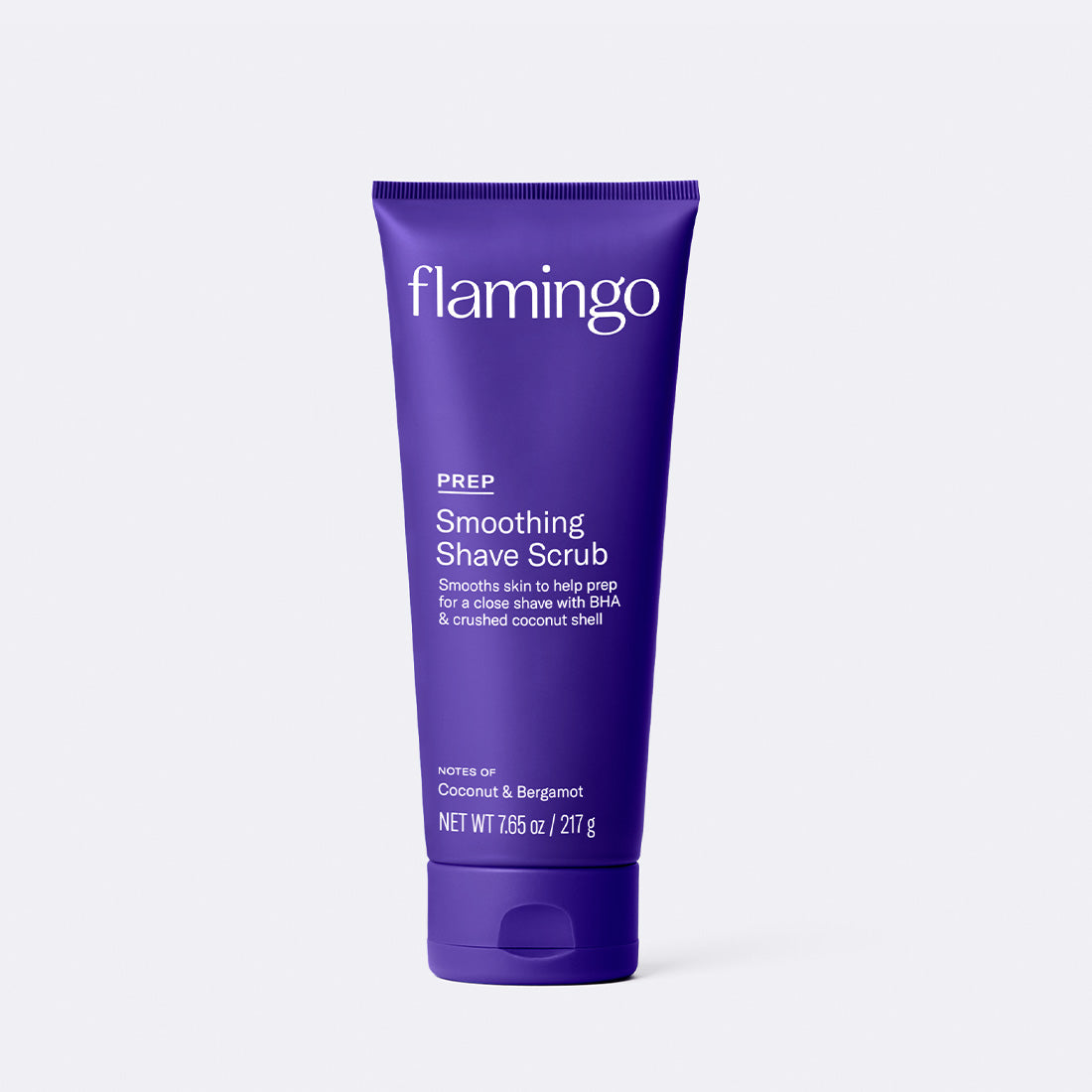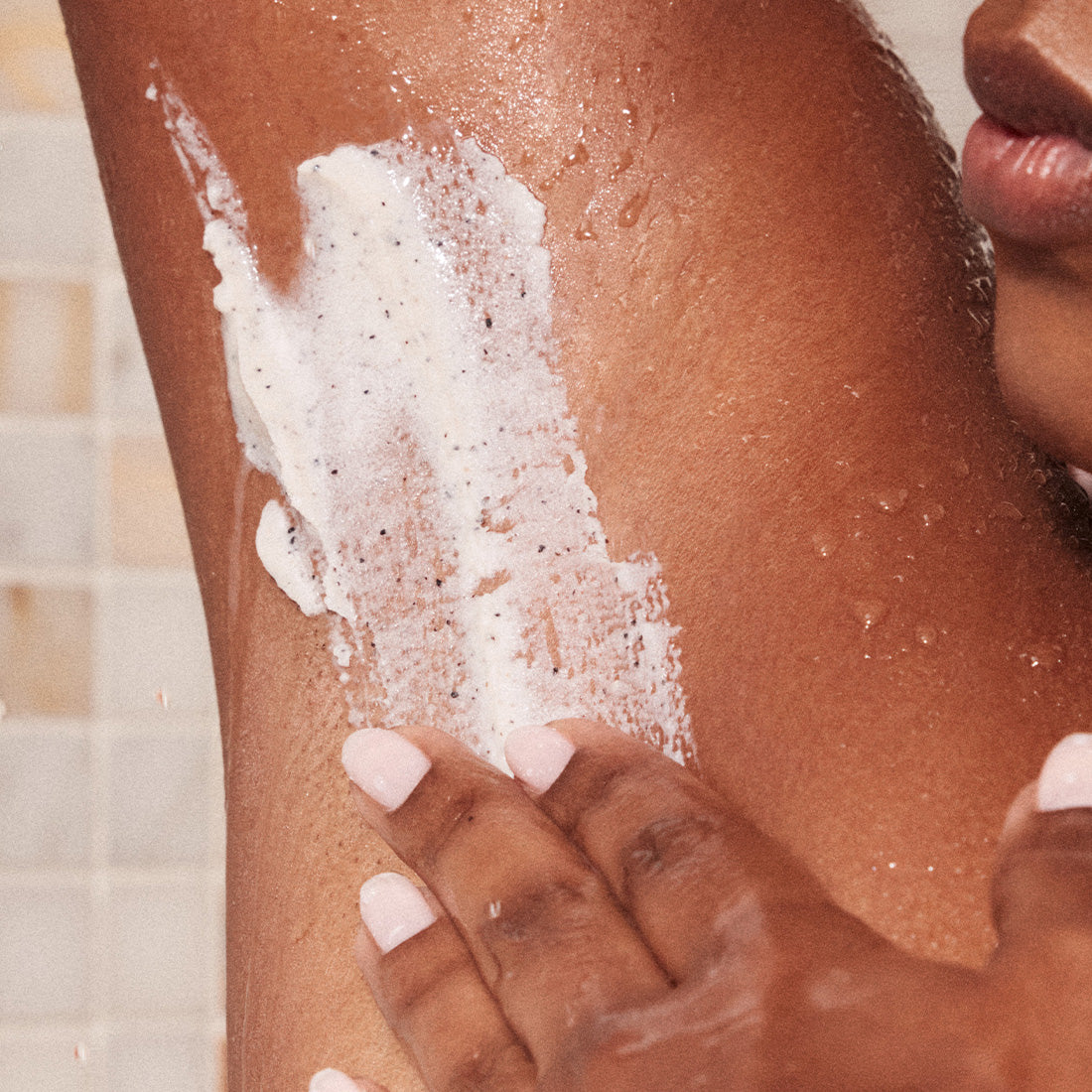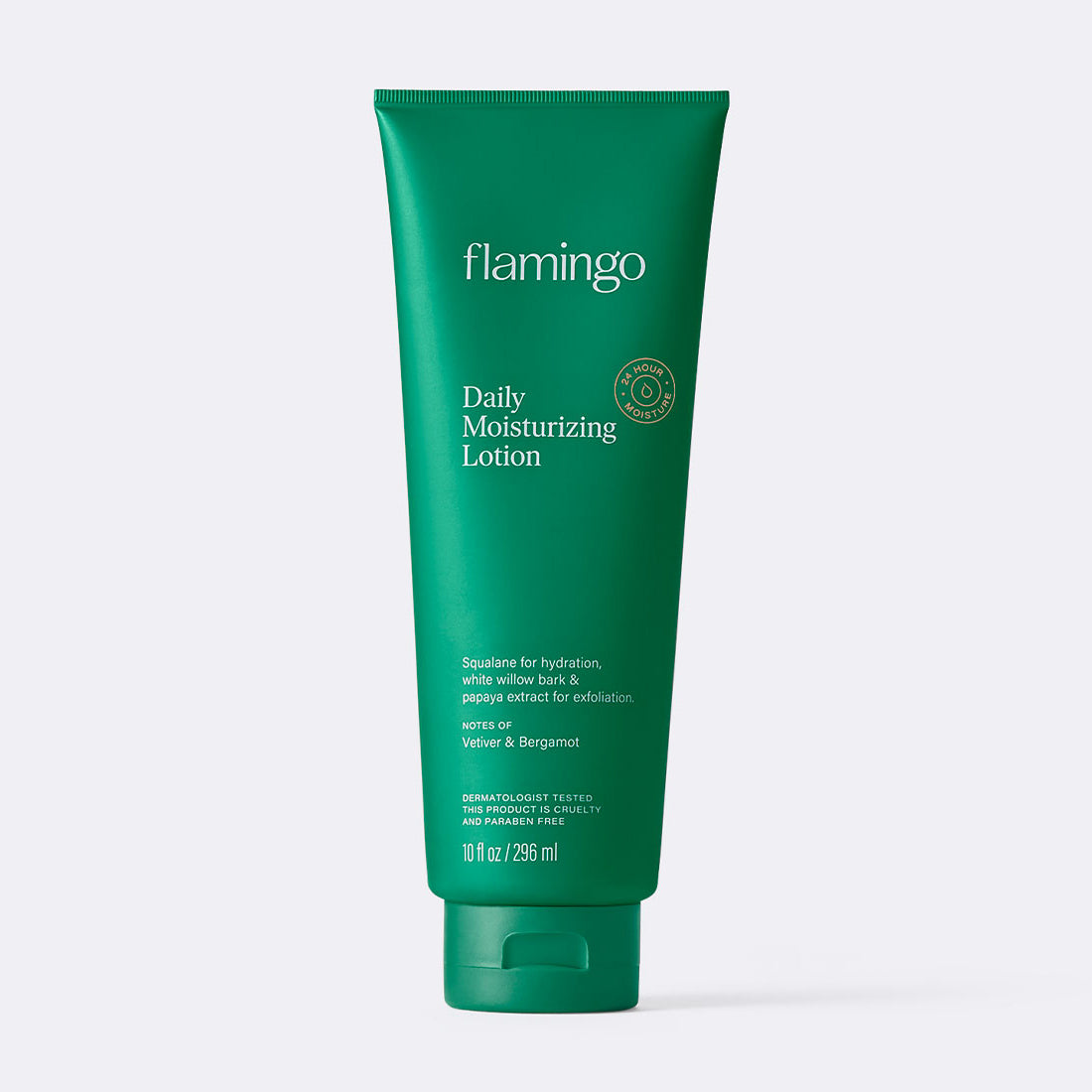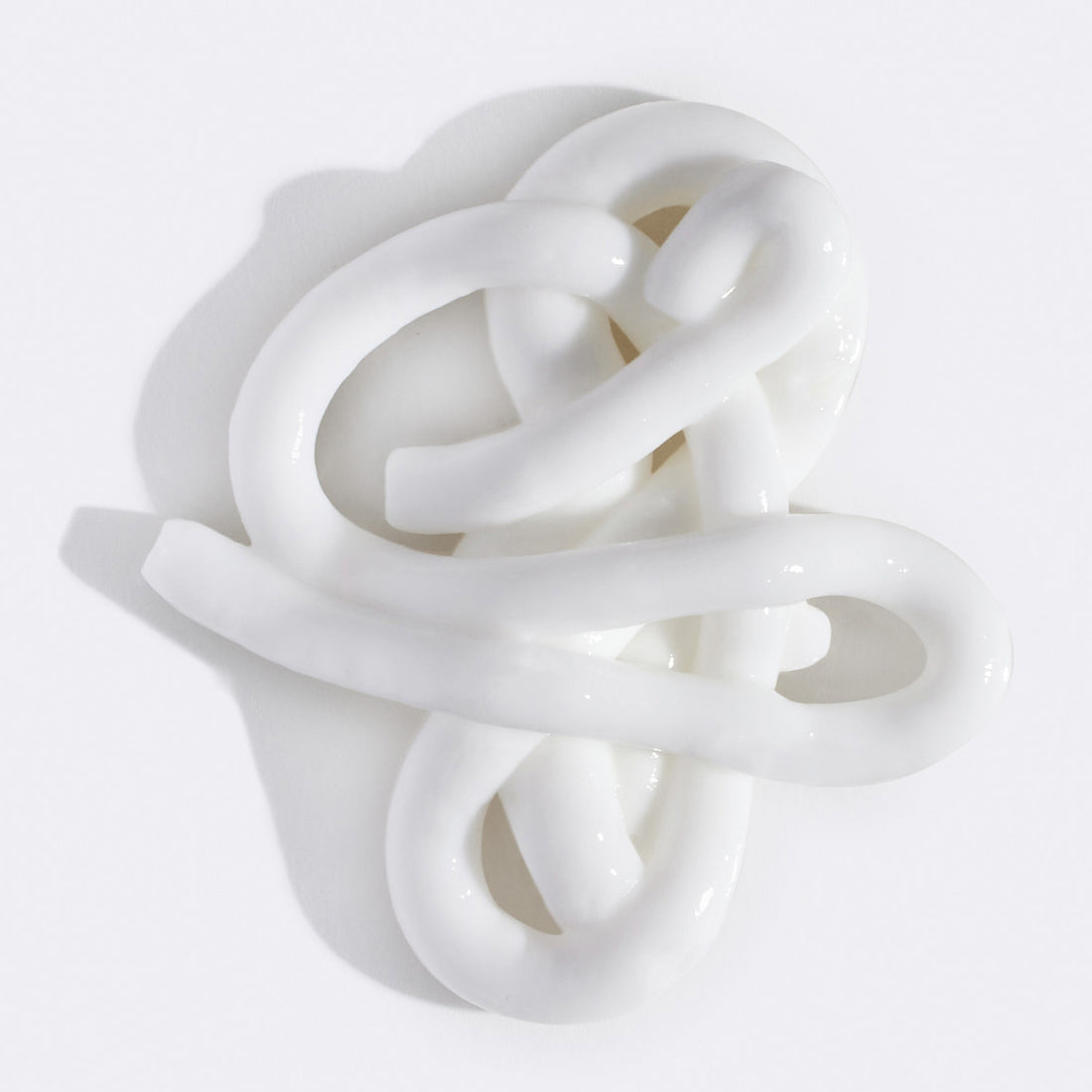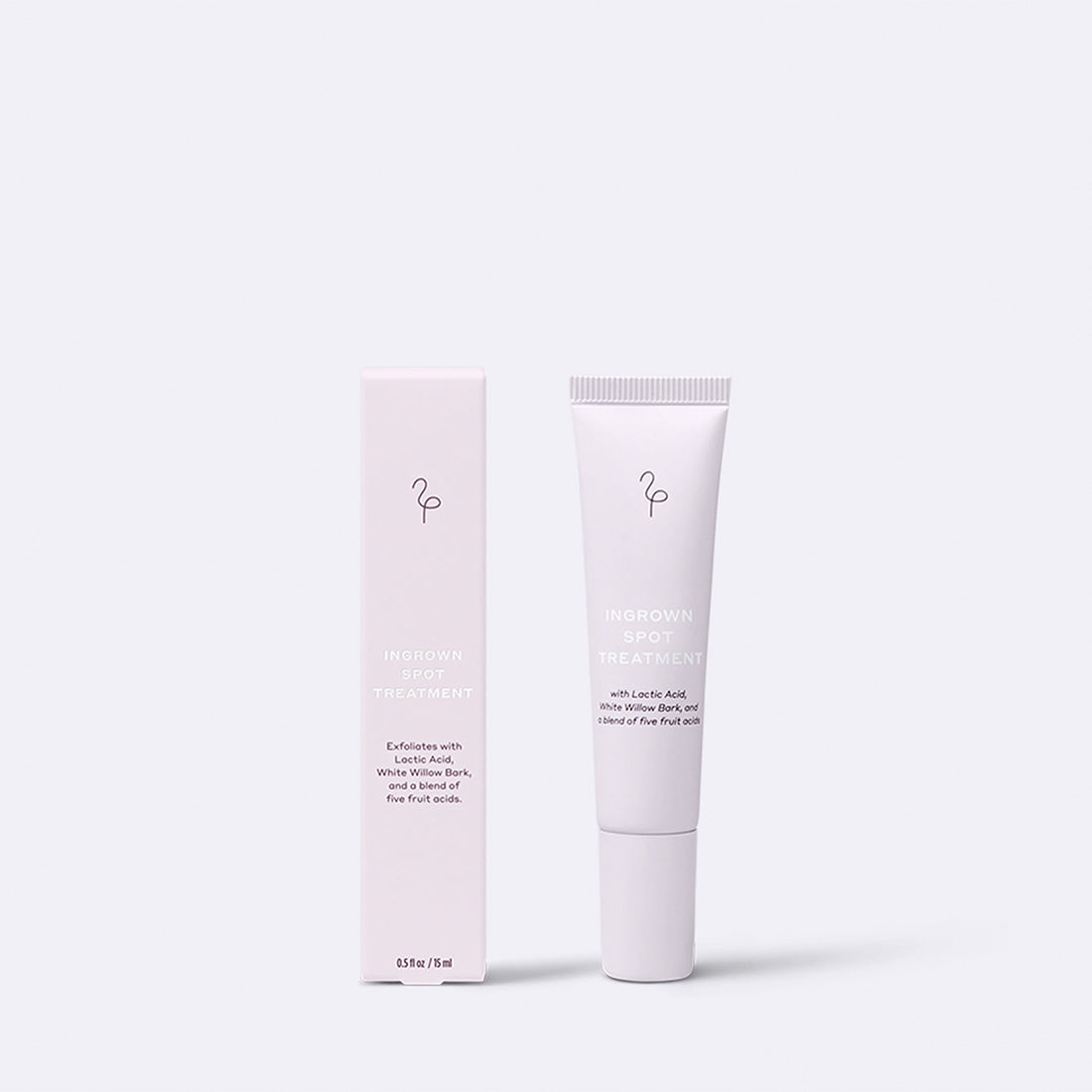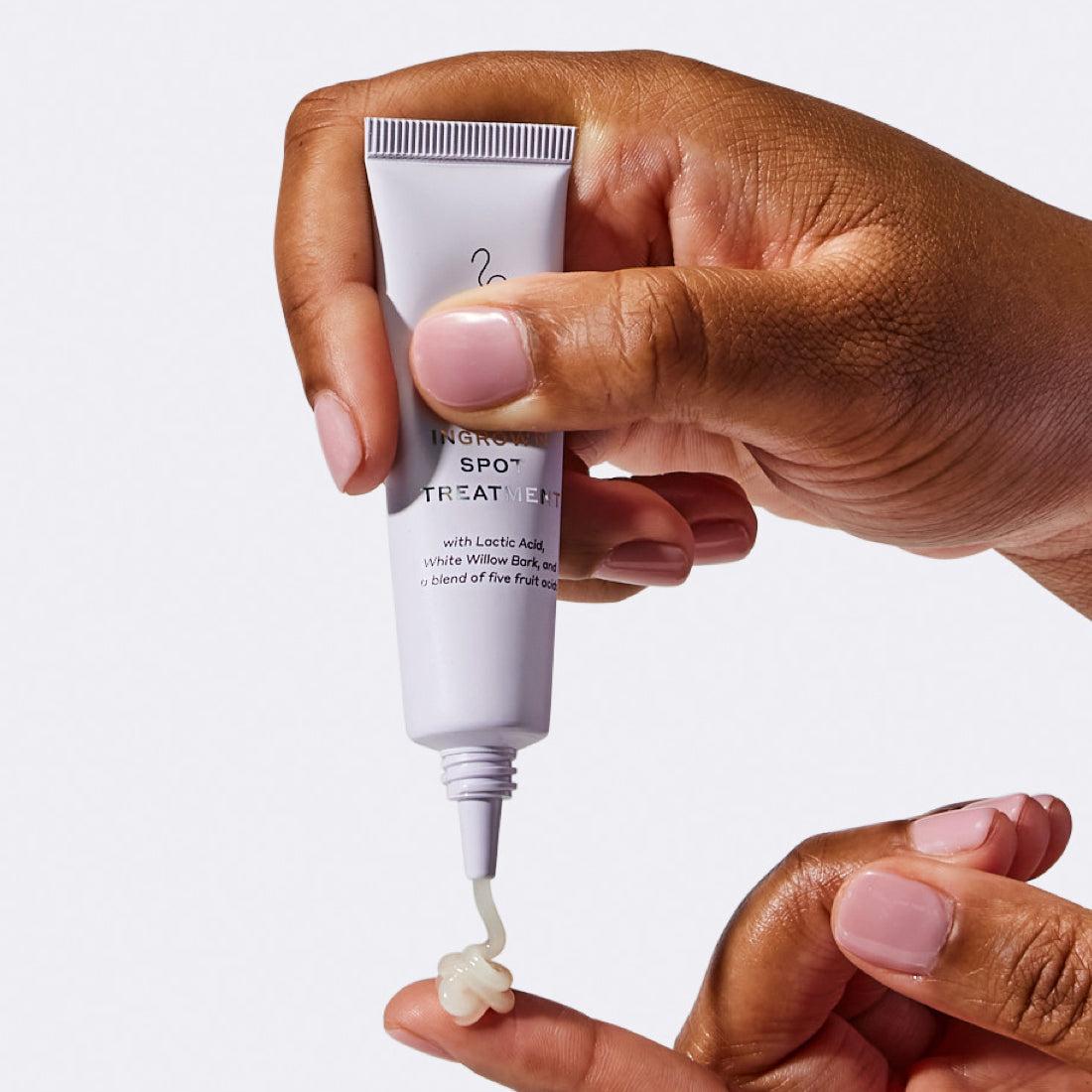INGROWN HAIRS CAN BE A PAIN—literally. These pesky little bumps are an extremely annoying, but completely normal part of having body hair. Sometimes after you shave, wax, or tweeze, a hair can curl and grow inward, causing a small bump that looks like a pimple. They can happen to anyone, but especially people with thick and curly hair. Dry skin can also encourage ingrown hairs because loose dead skin cells can block hair from breaking through the surface. Thankfully, you can help prevent ingrown hairs by adding an extra step to your routine: exfoliation. As hair removal experts, we’ve compiled the best tips and tricks, so read on to learn how to get that smooth, ingrown-free skin you deserve.
Why Does Exfoliating Help Prevent Ingrown Hairs?
Dead skin cells can block your hair follicles, causing the hair to grow inward and create a bump. Exfoliating removes dead skin cells from the surface, allowing the hair to move freely from the follicle. There are two kinds of exfoliating: physical (like using a body scrub or loofah) and chemical (like using a body wash with an acid).
Benefits of Regular Exfoliation
It might sound intimidating to add exfoliation to your hair removal routine, but the benefits are worth the little bit of extra effort. Removing dead skin cells can help reduce the chance of ingrown hairs, plus exfoliating helps get rid of any oil or dirt that have accumulated on your skin. Exfoliating can also improve your skin’s texture and leave it feeling smoother. By removing the barrier of dead skin cells, it can even help the absorption of skincare products you apply afterward.
Types of Exfoliation for Preventing Ingrown Hairs
-
Physical Exfoliation
The most common product for physical exfoliation is a textured body scrub. Body scrubs usually have a physical exfoliant (like sugar, salt, or even coffee grounds!) and a carrier oil (like coconut or olive oil), plus fragrance or other ingredients for added benefits.
You can also use a physical tool for exfoliation, like a textured washcloth, an exfoliation glove, or a dry brush.
-
Chemical Exfoliation
Chemical exfoliation uses (you guessed it) chemical based acids to remove dead skin by breaking the bonds that hold skin cells together. Alpha hydroxy acids (AHAs), like glycolic and lactic acid, and beta hydroxy acids (BHAs), like salicylic acid, are the most common chemical exfoliators. You can usually find them in body washes and peels.
-
Enzyme Exfoliation
Enzymes work like a gentler version of chemical acids because they help break down dead skin cells, but don’t affect living skin cells. This makes them a great option for those with sensitive skin. They’re usually derived from fruits like pineapple and papaya and can also be found in body washes and peels.
Chemical vs. Physical Exfoliants
Like with all skincare methods, there are pros and cons to both kinds of exfoliation. Physical exfoliation can be satisfying because the results are immediate and you can actually see dead skin being removed. However, it can sometimes result in micro tears and irritation, especially if you do it too frequently. Chemical exfoliation tends to be gentler and less abrasive, so it’s good for more sensitive skin.
AHAs vs. BHAs
AHAs and BHAs both work on the skin’s surface to encourage skin cell turnover, but BHAs also work within the pores. This is why you often see BHAs like salicylic acid recommended for clogged pores and acne, while AHAs like glycolic acid are usually recommended to treat wrinkles and sun damage. BHAs are also considered slightly milder, so they also can be good if you have more sensitive skin. For the purpose of regular exfoliation to prevent ingrown hairs, either kind of acid can be useful.
How to Exfoliate to Prevent Ingrown Hairs
-
Cleanse
To get the most out of your exfoliator, first cleanse your skin with a gentle soap or body wash to remove any superficial dirt or oil. Use warm water, which can help open your hair follicles and pores.
-
Exfoliate
Apply a body scrub or body wash with chemical exfoliants in a circular motion. Rinse skin and pat dry.
To avoid irritating skin, exfoliate no more than two to three times a week.
We recommend using Flamingo Smoothing Shave Prep Scrub, a gentle body scrub that’s safe for sensitive skin and made with a combination of chemical & physical exfoliants. If you’re shaving your pubic area, we recommend Flamingo Pubic Exfoliating Shave Gel, a gynecologist tested formula that’s made with 5 fruit acids to gently remove dead skin cells.
-
Moisturize
To hydrate and help skin recover after exfoliating, apply a moisturizing body lotion or cream. We recommend Flamingo Daily Moisturizing Lotion, which is made with squalane for long lasting moisture, along with white willow bark and papaya extract to encourage natural skin cell turnover.
If you’re going outside right after exfoliating, be sure to apply SPF.
Exfoliating & Hair Removal
-
Exfoliating & Shaving
Dead skin cells not only cause ingrown hairs, but they can clog your razor blades. Clean razor blades mean a better shave, with less chance of razor burn. Exfoliating before shaving can help ensure smooth results without irritation.
Don’t exfoliate after shaving because it could irritate your freshly shaven skin. It’s best to exfoliate as part of your shave prep routine, then apply a soothing moisturizer after. Flamingo Soothing Post Shave Serum is another great option that’s dermatologist tested and safe for sensitive skin. It contains hyaluronic acid to hydrate skin, calming ginger root extract to help reduce the appearance of post-shave redness, and coconut oil to leave skin soft and glowing.
-
Exfoliating & Waxing
When you remove hair from the root by waxing, it can alter the hair follicle. This can make hair grow inward instead of outward as it normally would. Regularly removing dead skin cells by exfoliating can help stop this hair from getting trapped and causing an ingrown.
Exfoliating before waxing does require some lead time, since it can make your skin more sensitive. Exfoliate at least two days before you plan to wax, then wait at least two days after you wax to resume exfoliating again.
-
Exfoliating & Laser Hair Removal
Laser hair removal can be a great (but expensive) option for people who are prone to ingrowns because it uses laser light to permanently destroy hair follicles, stopping future hair growth and causing existing hairs to fall out. In the midst of laser hair removal, it can be beneficial to gently exfoliate skin to both prevent ingrown hairs and help speed up the pace of post-procedure hair shedding.
Our general advice is to exfoliate before your laser hair removal procedure, then wait at least two after your treatment to resume exfoliating again, but check with your esthetician for their personalized recommendation.
Ingrown Hair Treatment
If an ingrown hair does appear, don’t panic! Avoid picking or touching the ingrown, which can cause further irritation or even infection. While ingrown hairs can be annoying, they usually go away on their own after a few days. Using Flamingo Ingrown Spot Treatment can help with the process. It’s a dermatologist and gynecologist tested, targeted solution to soothe visible redness and gently exfoliate ingrown hairs with white willow bark, lactic acid, and bisabolol.
Common Exfoliation Mistakes to Avoid
-
Over-Exfoliating & Damaging the Skin Barrier
There can be too much of a good thing when it comes to exfoliating. If you do it too frequently, you can damage your skin’s barrier. To avoid irritating skin, exfoliate no more than two to three times a week.
-
Using Harsh Scrubs on Sensitive Areas
Be mindful of exfoliating sensitive areas, like your pubic area and bikini line. Thankfully there are products that are specifically formulated to be gentle on pubic skin, like Flamingo Pubic Exfoliating Shave Gel, which is gynecologist and dermatologist tested.
-
Mixing Too Many Exfoliating Products
You only really need one great exfoliating product in your routine. Using both a body wash with a chemical exfoliant followed by a body scrub can irritate your skin barrier from too much exfoliating. On days you exfoliate, try to use gentle products without active ingredients in the rest of your routine.
-
Not Following Up With Hydration
On that note, it’s always important to follow exfoliation with a hydrating body lotion to lock in moisture, help calm skin, and restore your skin’s natural barrier. Think of exfoliating and moisturizing like a one-two punch to help prevent ingrown hairs.
Conclusion
Adding exfoliation to your body care routine can help prevent ingrown hairs and ensure soft, smooth skin with just a few steps:
-
Cleanse skin before exfoliating to remove superficial dirt and oil
-
Apply a physical or chemical exfoliant in circular motions to your skin
-
Exfoliate before hair removal to help prevent ingrown hairs
-
Hydrate skin with a moisturizing body lotion after
Recommended Products
Flamingo Smoothing Shave Scrub
Flamingo Pubic Exfoliating Shave Gel
Flamingo Daily Moisturizing Lotion
Flamingo Ingrown Spot Treatment
FAQs
How often should I exfoliate to prevent ingrown hairs?
We recommend exfoliating no more than two to three times a week.
Should I exfoliate before or after shaving?
The best way to prevent ingrown hairs after shaving is to exfoliate before and remove dead skin cells. Exfoliating right after shaving can actually irritate skin, so we don’t recommend it.
Can I use chemical and physical exfoliation together?
We wouldn’t recommend using two chemical and physical exfoliants together to avoid over-exfoliating your skin. The exception would be while using a product that’s specifically formulated with both chemical and physical exfoliants, like Flamingo Smoothing Shave Scrub.
What ingredients help prevent ingrown hairs?
Alpha hydroxy acids (AHAs), like glycolic and lactic acid, and beta hydroxy acids (BHAs), like salicylic acid, help prevent ingrown hairs by exfoliating skin.
What’s the best exfoliant for sensitive skin?
We recommend Flamingo Smoothing Shave Scrub, which is safe for sensitive skin.


